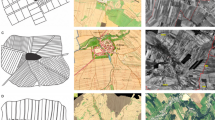Abstract
Maasai settlements in Amboseli are distributed in a pattern which reflects various physical and biological characteristics of the landscape. The settlements avoid hillslope gradients exceeding 0.08, and the lower sections of long hillsides, which receive large amounts of runoff. Long, relatively high hillslopes are difficult for exhausted cattle to climb at the end of the dry season, and even the welldrained sites at the upper ends of these slopes are not commonly used. Deep, poorly drained, and light-colored soils are avoided because they affect the comfort of humans, and especially the milk production of cattle. The settlements are located away from dense tree and bush vegetation because of the danger of predators, but during occupation of the site important changes in the vegetation are wrought by the use of trees for settlement construction and firewood. The reasons for the pattern were elucidated by making a set of systematic measurements of settlement distributions and various environmental factors. The conclusions of this analysis were then checked and extended through conversations with Maasai elders. These latter exhibited a sophisticated knowledge of environmental characteristics and processes which is reflected in their choice of settlement sites. Such knowledge has commonly been overlooked by other writers on the subject of pastoralism.
Similar content being viewed by others
References
Blaxter, K. L. (1962).Energy Metabolism of the Ruminants. Hutchinson, London.
Cooper, C. F. (1963). An evaluation of variable plot sampling in shrub and herbaceous vegetation.Ecology 44: 565–568.
Dale, I. R., and Greenway, P. J. (1961).Kenya Trees and Shrubs. Hatchards, Nairobi.
Dyson-Hudson, N. (1966).Karamojong Politics. Clarendon Press, Oxford.
Dyson-Hudson, R. (1972). Pastoralism: Self image and behavioural reality.Journal of Asian and African Studies 7(1–2): 30–47.
Evans-Pritchard, E. E. (1940).The Nuer. Clarendon Press, Oxford.
Geiger, R. (1965).The Climate Near the Ground. Harvard Univ. Press, Cambridge.
Greig-Smith, P. (1957).Quantitative Plant Ecology. Butterworths, London.
Gulliver, P. H. (1955).The Family Herds. Routledge and Kegan Paul, London.
Jacobs, A. L. (1965). The traditional political organizations of the pastoral Maasai, D. Phil. Thesis, Oxford University.
Klima, C. J. (1969).The Barabaig, East African Cattle-Herders. Holt, Rinehart and Winston, New York.
Krumbein, W. C., and Graybill, F. A. (1965).An Introduction to Statistical Models in Geology. McGraw-Hill, New York.
Leopold, L. B. (1970). An improved method for size distribution of stream bed gravel.Water Resources Research 6: 1357–1366.
Leopold, L. B., Wolman, M. G., and Miller, J. P. (1964).Fluvial Processes in Geomorphology. Freeman, San Francisco.
Pratt, D. J., Greenway, P. J., and Gwynne, M. D. (1966). A classification of East African rangeland, with an appendix on terminology.Journal of Applied Ecology 3: 369–382.
Robertshaw, D., and Katongole, C. B. (1969). Adreno-cortical activity and intermediary metabolism ofBos indiens andBos taurus in the high altitude (2,000 metres) tropics.Biometeorology 4: 101.
Spencer, P. (1973).Nomads in Alliance: Symbiosis and Growth among the Rendille and Samburu of Kenya. Oxford University Press, London.
Stenning, D. J. (1957).Savannah Nomads; A study of the Wodaaba Pastoral Fulani of Western Bornu Province, Northern Region, Nigeria. Oxford University Press, London.
Taylor, C. R. (1969). Metabolism, respiratory changes and water balance of an antelope, the eland.American Journal of Physiology 217: 317–320.
Western, D. (1973). The structure, dynamics and changes of the Amboseli Ecosystem. Ph.D. thesis, University of Nairobi.
Western, D. (1975). Water availability and its influence of the structure and dynamics of a savannah large mammal community.East African Wildlife Journal 13.
Western, D., and Sindiyo, D. M. (1972). The status of the Amboseli rhino population.East African Wildlife Journal 10: 43–57.
Author information
Authors and Affiliations
Rights and permissions
About this article
Cite this article
Western, D., Dunne, T. Environmental aspects of settlement site decisions among pastoral Maasai. Hum Ecol 7, 75–98 (1979). https://doi.org/10.1007/BF00889353
Issue Date:
DOI: https://doi.org/10.1007/BF00889353




